Recently I fixed my pool's auto-fill so I no longer have any iron being added to the pool (How to test for Iron without sending out water to testing lab or pool store! (pics included)) , but I was curious if I still had some iron in the pool water from the last 3 months that was still lingering around. I've drained a bit of pool water lately (maybe 6,000 of my 36,000 gallons?) to get rid of some of the sequestered iron and some CH as well.
Normally I keep FC around 4-6 or so, and decided to try to make my pool turn nuclear green with some added chlorine. I like to call it nuclear green because the water is still super clear and it just reminds me of some kind of weird nuclear waste water.
Now on to the fun stuff...
I can go from super-clear blue to super-clear green by bumping up my FC from 4-6 to 14. It only takes a couple of hours (maybe 4, IIRC?) for the water to change that drastically. Keep in mind, I'm not doing this with 1 pump, I had 3 separate pumps running (1 at 2750rpm, 1 at 1050rpm, and 1 at 1550rpm) to keep water circulating really well during this test.
IMPORTANT NOTE: The main pool and the overflow basin are 2 different shades/colors in each picture because I started my experiment/testing the overflow basin about an HOUR ahead of the main pool. (I wasn't going to proceed with the main pool if I didn't see the results I -expected- with the smaller overflow basin). So every pic you see here, the overflow basin will have a "head start", hence the difference in colors between the two bodies of water.
In short, I just used a very small amount of AA to neutralize -some- of the FC and ran 3 pumps to circulate and move the water.
This is the the water color in the beginning, once FC hit about 14.5.
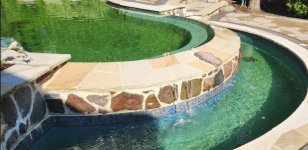
1 Hour Later after adding in a bit of AA...
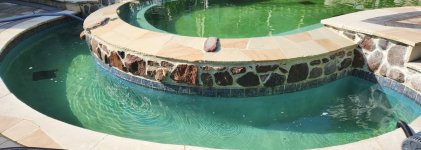
1 Hour Later with circulation (no more AA being added)...
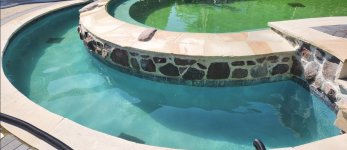
1 Hour Later with circulation (no more AA being added)...
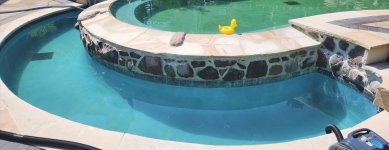
1 Hour 30 Minutes Later with circulation (no more AA being added)...
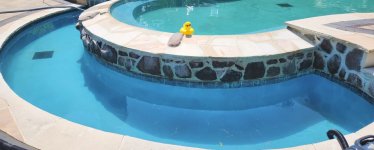
2.5 Hours later with circulation (no more AA being added)...
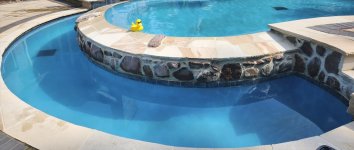
Basically about 7 hours total of water circulation, and an FC drop from 14 down to about 5. So this shows that I still have some iron in my pool.
In a span of about 12 hours, I went from clear-blue, to clear-green, to clear-blue again. Anyways, just thought it might be fun to share with others.! (iron sucks, heh)
Normally I keep FC around 4-6 or so, and decided to try to make my pool turn nuclear green with some added chlorine. I like to call it nuclear green because the water is still super clear and it just reminds me of some kind of weird nuclear waste water.
Now on to the fun stuff...
I can go from super-clear blue to super-clear green by bumping up my FC from 4-6 to 14. It only takes a couple of hours (maybe 4, IIRC?) for the water to change that drastically. Keep in mind, I'm not doing this with 1 pump, I had 3 separate pumps running (1 at 2750rpm, 1 at 1050rpm, and 1 at 1550rpm) to keep water circulating really well during this test.
IMPORTANT NOTE: The main pool and the overflow basin are 2 different shades/colors in each picture because I started my experiment/testing the overflow basin about an HOUR ahead of the main pool. (I wasn't going to proceed with the main pool if I didn't see the results I -expected- with the smaller overflow basin). So every pic you see here, the overflow basin will have a "head start", hence the difference in colors between the two bodies of water.
In short, I just used a very small amount of AA to neutralize -some- of the FC and ran 3 pumps to circulate and move the water.
This is the the water color in the beginning, once FC hit about 14.5.

1 Hour Later after adding in a bit of AA...

1 Hour Later with circulation (no more AA being added)...

1 Hour Later with circulation (no more AA being added)...

1 Hour 30 Minutes Later with circulation (no more AA being added)...

2.5 Hours later with circulation (no more AA being added)...

Basically about 7 hours total of water circulation, and an FC drop from 14 down to about 5. So this shows that I still have some iron in my pool.
In a span of about 12 hours, I went from clear-blue, to clear-green, to clear-blue again. Anyways, just thought it might be fun to share with others.! (iron sucks, heh)


